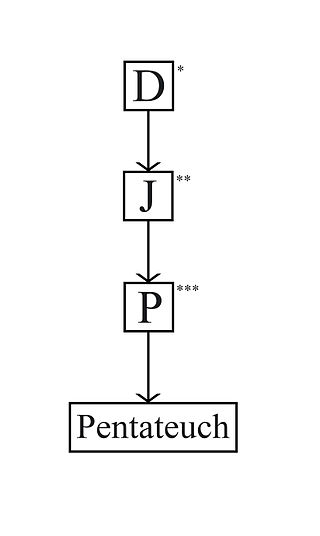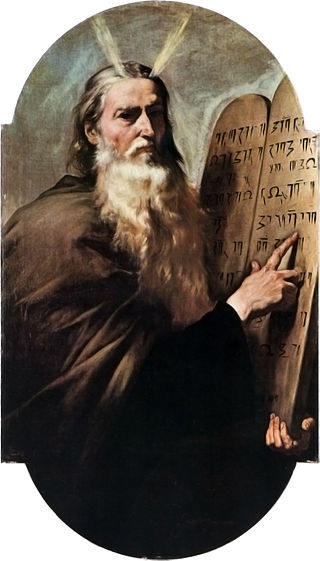The Book of Numbers is the fourth book of the Hebrew Bible and the fourth of five books of the Jewish Torah. The book has a long and complex history; its final form is possibly due to a Priestly redaction of a Yahwistic source made sometime in the early Persian period. The name of the book comes from the two censuses taken of the Israelites.
The Book of Exodus is the second religious book of the Bible. It is a narrative of the Exodus, the origin myth of the Israelites leaving slavery in Biblical Egypt through the strength of their deity named Yahweh, who according to the story chose them as his people. The Israelites then journey with the legendary prophet Moses to Mount Sinai, where Yahweh gives the 10 commandments and they enter into a covenant with Yahweh, who promises to make them a "holy nation, and a kingdom of priests" on condition of their faithfulness. He gives them their laws and instructions to build the Tabernacle, the means by which he will come from heaven and dwell with them and lead them in a holy war to conquer Canaan, which has earlier, according to the myth of Genesis, been promised to the "seed" of Abraham, the legendary patriarch of the Israelites.
The Book of Genesis is the first book of the Hebrew Bible and the Christian Old Testament. Its Hebrew name is the same as its first word, Bereshit. Genesis is an account of the creation of the world, the early history of humanity, and of Israel's ancestors and the origins of the Jewish people.

The Torah is the compilation of the first five books of the Hebrew Bible, namely the books of Genesis, Exodus, Leviticus, Numbers and Deuteronomy. It is known as the Pentateuch or the Five Books of Moses by Christians. It is also known as the Written Torah in Jewish tradition. If meant for liturgic purposes, it takes the form of a Torah scroll. If in bound book form, it is called Chumash, and is usually printed with the rabbinic commentaries.

The documentary hypothesis (DH) is one of the models used by biblical scholars to explain the origins and composition of the Torah. A version of the documentary hypothesis, frequently identified with the German scholar Julius Wellhausen, was almost universally accepted for most of the 20th century. It posited that the Pentateuch is a compilation of four originally independent documents: the Jahwist (J), Elohist (E), Deuteronomist (D), and Priestly (P) sources. The first of these, J, was dated to the Solomonic period. E was dated somewhat later, in the 9th century BCE, and D was dated just before the reign of King Josiah, in the 7th or 8th century BCE. Finally, P was generally dated to the time of Ezra in the 5th century BCE. The sources would have been joined together at various points in time by a series of editors or "redactors".
The Deuteronomist, abbreviated as either Dtr or simply D, may refer either to the source document underlying the core chapters (12–26) of the Book of Deuteronomy, or to the broader "school" that produced all of Deuteronomy as well as the Deuteronomistic history of Joshua, Judges, Samuel, Kings, and also the Book of Jeremiah. The adjectives "Deuteronomic" and "Deuteronomistic" are sometimes used interchangeably; if they are distinguished, then the first refers to the core of Deuteronomy and the second to all of Deuteronomy and the history.

The Jahwist, or Yahwist, often abbreviated J, is one of the most widely recognized sources of the Pentateuch (Torah), together with the Deuteronomist, the Priestly source and the Elohist. The existence of the Jahwist is somewhat controversial, with a number of scholars, especially in Europe, denying that it ever existed as a coherent independent document. Nevertheless, many scholars do assume its existence. The Jahwist is so named because of its characteristic use of the term Yahweh for God.

The Priestly source is perhaps the most widely recognized of the sources underlying the Torah. It is both stylistically and theologically distinct from other material in the Torah, and includes a set of claims that are contradicted by non-Priestly passages and therefore uniquely characteristic: no sacrifice before the institution is ordained by Yahweh (God) at Sinai, the exalted status of Aaron and the priesthood, and the use of the divine title El Shaddai before God reveals his name to Moses, to name a few. In general, the Priestly work is concerned with priestly matters – ritual law, the origins of shrines and rituals, and genealogies – all expressed in a formal, repetitive style. It stresses the rules and rituals of worship, and the crucial role of priests, expanding considerably on the role given to Aaron.

The Exodus is the founding myth of the Israelites whose narrative is spread over four books of the Torah, namely Exodus, Leviticus, Numbers, and Deuteronomy.

The Ritual Decalogue is a list of laws at Exodus 34:11–26. These laws are similar to the Covenant Code and are followed by the phrase "ten commandments". Although the phrase "Ten Commandments" has traditionally been interpreted as referring to a very different set of laws, in Exodus 20:2–17, many scholars believe it instead refers to the Ritual Decalogue found two verses earlier.
John Van Seters is a Canadian scholar of the Hebrew Bible and the Ancient Near East. Currently University Distinguished Professor Emeritus at the University of North Carolina, he was formerly James A. Gray Professor of Biblical Literature at UNC. He took his Ph.D. at Yale University in Near Eastern Studies (1965) and a Th.D. h.c. from the University of Lausanne (1999). His honours and awards include a Guggenheim Fellowship, an NEH fellowship, an ACLS Fellowship, and research fellowships at Oxford, Cambridge, Katholieke Universiteit Leuven, and National Research Foundation of South Africa. His many publications include The Hyksos: A New Investigation (1966); Abraham in History and Tradition (1975); In Search of History ; The Edited Bible (2006); and The Biblical Saga of King David (2009).
The Covenant Code, or Book of the Covenant, is the name given by academics to a text appearing in the Torah, at Exodus 20:22–23:19; or, more strictly, the term Covenant Code may be applied to Exodus 21:1–22:16. Biblically, the text is the second of the law codes said to have been given to Moses by God at Mount Sinai. This legal text provides a small but substantive proportion of the mitzvot within the Torah, and hence is a source of Jewish Law.
Massah and Meribah are place names found in the Hebrew Bible. The Israelites are said to have travelled through Massah and Meribah during the Exodus, although the continuous list of visited stations in Numbers 33 does not mention this. In Exodus 17:7, Meribah is mentioned at the same time as Massah, in a context which suggests that Massah is the same location as Meribah, but other biblical mentions of Massah and Meribah, such as that in the Blessing of Moses seem to imply that they are distinct. Massah and Meribah are also referred to in several other places in the Bible.

Mosaic authorship is the Judeo-Christian tradition that the Torah, the first five books of the Hebrew Bible/Old Testament, were dictated by God to Moses. The tradition probably began with the legalistic code of the Book of Deuteronomy and was then gradually extended until Moses, as the central character, came to be regarded not just as the mediator of law but as author of both laws and narrative.
Prolegomena zur Geschichte Israels is a book by German biblical scholar and orientalist Julius Wellhausen (1844–1918) that formulated but did not found the documentary hypothesis, a theory on the composition history of the Torah or Pentateuch. Influential and long debated, the volume is often compared for its impact in its field with Charles Darwin's 1859 work, On the Origin of Species.

The Bible with Sources Revealed (2003) is a book by American biblical scholar Richard Elliott Friedman dealing with the process by which the five books of the Torah or Pentateuch came to be written. Friedman follows the four-source documentary hypothesis model, but differs significantly from Julius Wellhausen's model in several respects.
Source criticism, in biblical criticism, refers to the attempt to establish the sources used by the authors and redactors of a biblical text. It originated in the 18th century with the work of Jean Astruc, who adapted the methods already developed for investigating the texts of classical antiquity to his own investigation into the sources of the Book of Genesis. It was subsequently considerably developed by German scholars in what was known as "the higher criticism", a term no longer in widespread use. The ultimate aim of these scholars was to reconstruct the history of the biblical text and also the religious history of ancient Israel.

In biblical studies, the supplementary hypothesis proposes that the Pentateuch was derived from a series of direct additions to an existing corpus of work. It serves as a revision to the earlier documentary hypothesis, which proposed that independent and complete narratives were later combined by redactors to create the Pentateuch.

The primeval history is the name given by biblical scholars to the first eleven chapters of the Book of Genesis in the Hebrew Bible. These chapters convey the story of the first years of the world's existence.
The composition of the Torah was a process that involved multiple authors over an extended period of time. While Jewish tradition holds that all five books were originally written by Moses sometime in the 2nd millennium BCE, leading scholars have rejected Mosaic authorship since the 17th century.








